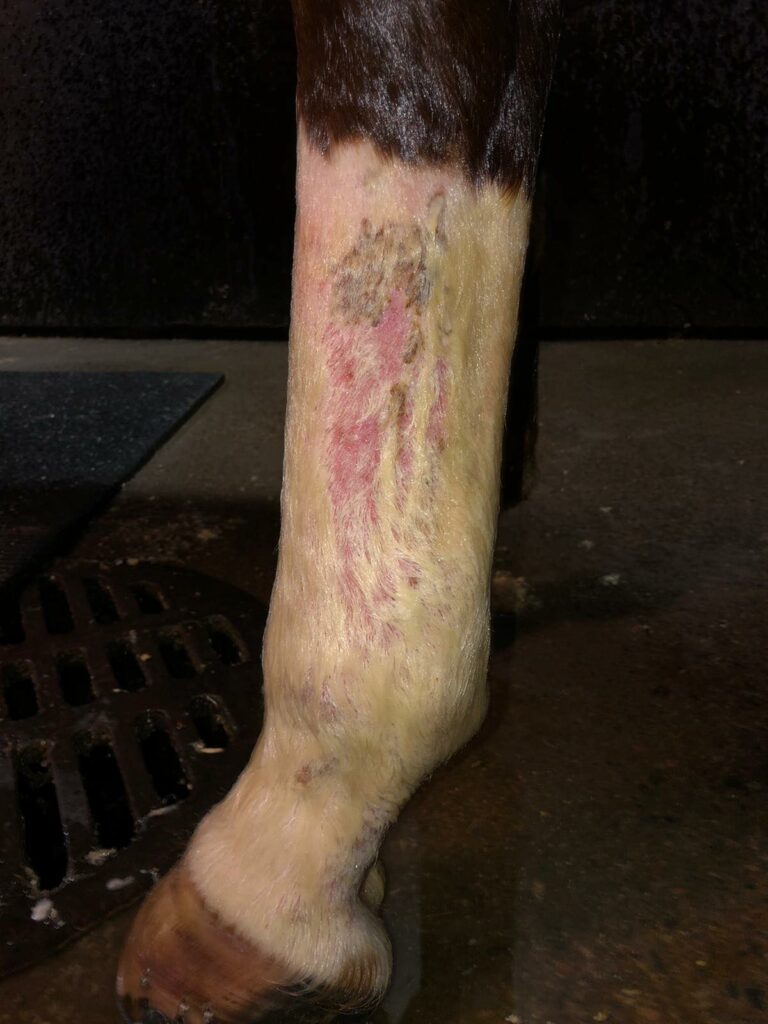Dog's hotspot, paw infection, furunculosis and horse's mud fever and skin infections
Typical skin infections
Typical skin infections in dogs are hotspot, paw infection and yeast infections in different areas, such as yeast in the anus, lips, paws and ears. In horses, mud fever, ringworm, scabies and fungal infections are typical skin infections.
Below are general instructions for the treatment of different skin infections, hotspot, paw infection and horses’ mud fever. In addition, treatment instructions for yeast infections in dogs and fungal infections in horses are separately below. For furunculosis in dogs, talk to your vet about the need for topical treatment. SOLHEDS Derma products are well suited for the topical treatment of furunculosis and to support medical treatment.
Many of the causative agents/microbes of serious skin infections are anaerobic, i.e. bacteria that live in oxygen-free conditions. That is why it is important that oxygen-free conditions do not develop on the skin, e.g. using thick creams and thick fur. The area should be carefully shaved.
If the skin inflammation is widespread, long-lasting or severe, the veterinarian should always assess the situation and the need for systemic antimicrobial treatment.
You can find more detailed instructions for mud fever here.
The instructions for SOLHEDS natural products in the aid of management of the common skin infections: hotspot, mud fever, paw inflammation...
Wet and rinse off all dirt from the damaged skin. Massage Derma1 Skin Care shampoo carefully on affected area and leave for 3-10 minutes. The more severe the inflammation, the longer the leave in time. Rinse well and let the area dry/dry the affected area. Wash with the Derma1 shampoo can be repeated daily if necessary on the first week and 2-3 times per week after that. Even one time wash with Derma1 shampoo can be enough when combined with application of Derma5 Germ Fighting Cream. Derma 13 zinc solution cream is optimal choice for infections with excudate or when managing skin fold infections. Please note that the skin must be dry after washing. If washing is not possible and the inflamed area can otherwise be kept clean, Derma5 Germ Fighting wound cream can be used on the area.
Apply on dry and clean skin preferably twice a day with Derma5 Germ Fighting cream and in purulent skin infections with Derma13 Zinc Solution cream. In milder infections just wash with Derma1 shampoo is often sufficient. Clean towel should always be used when drying the skin.
More challenging infections will require a more active care plan. Recurring infections are often caused by allergies. Derma2 calming serum is an effective care option for this problem after wash with Derma1 skin care shampoo. Derma2 serum is an excellent base cream for reconditioning skin after skin infection and for renewal of hair growth.
Please note that a small amount of use is sufficient, e.g. a few drops of Derma1 shampoo for dogs’ wet paws is sufficient.
Antiseptic washing with Derma1 skin care shampoo, combined with the use of antimicrobial Derma5 Germ Fighting cream gives better treatment results than just washing or using the cream.
It is also advisable to trim the hair around the inflamed area to ensure proper ventilation. Avoid using thick ointments (paraffin- or petroleum-based) as they collect dirt and create favorable conditions for anaerobic pathogens.
Treatment of yeast infection in dogs
The treatment of yeast infection in dogs is based on antiseptic washes. Yeast infection in dogs is often a secondary infection, the result of decreased skin resistance to defend from external pathogens ( i.e. bacteria), usually due to an allergy. Yeast is also often found in skin folds in breeds with looser skin that has many folds. The causes and background factors of yeast infections in dogs should be discussed together with a veterinarian, so that the infections can be controlled in the future and to assess the need for other medication to manage yeast infections.
With the help of Derma1 skin care shampoo, the skin is washed with an antiseptic treatment to eradicate the yeast fungus. Derma1 shampoo also soothes the skin, reduces itching, and does not dry the skin. Wash regularly according to the based on the level of inflammation. Wet the skin and rub Derma1 skin care shampoo into the area to be treated, leave it on for 5-10 minutes and rinse. Please note that the skin must be dry after washing.
Derma8 Ear cleaner is suitable for washing yeast ear, to support medical treatment. Derma8 ear cleaner reduces itching, strengthens the skin barrier of the ear, suppresses yeast infection and cleans the ear effectively. Derma8 ear cleaner is also suitable for sensitive skin.
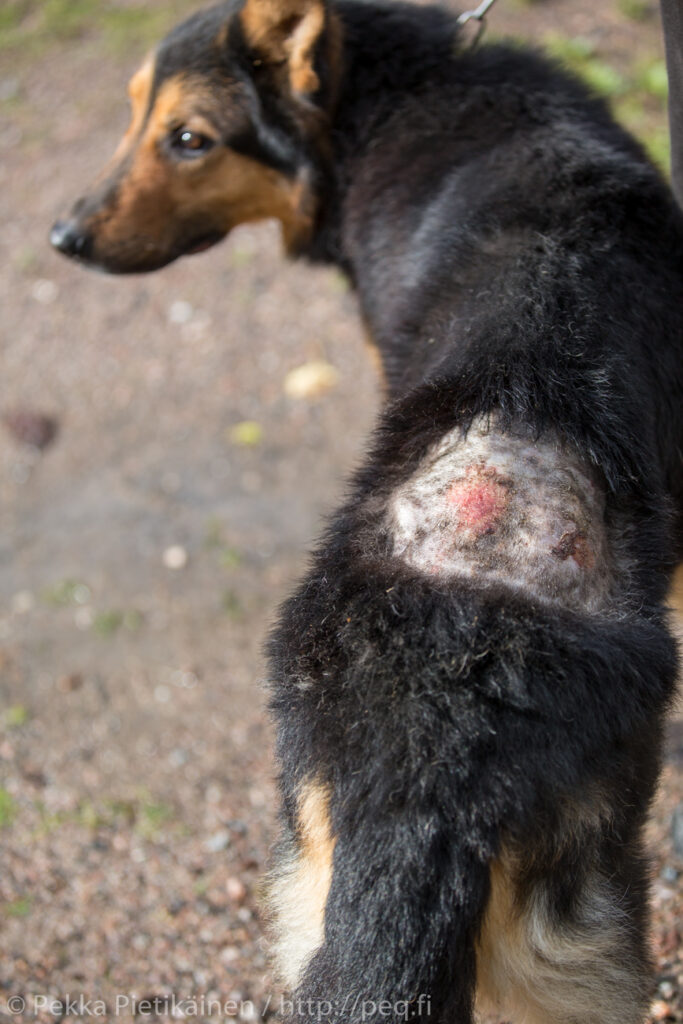
Horse fungal infections / ringworm
Fungal infections (dermatophytosis) in horses, popularly often called ringworm, can also heal on their own. The disease is contagious and therefore it is worth treating it in order to prevent the spread of the disease. It should be noted that the disease can also infect humans (zoonosis). Wash and disinfect your hands after handling the horse.
Derma1 skin care shampoo is effective against most different types of fungi. Wet the skin and rub Derma1 skin care shampoo into the area to be treated, leave it on for 10 minutes and rinse. Continue treatment daily for a week. Keep the horse isolated from other horses after washing treatment for 2-3 weeks. After the washing treatment period, you can treat the skin with Derma2 calming serum to support skin regeneration and hair growth. Please note that the skin must be dry after washing. Please be diligent with stable hygiene and disinfect the horse’s equipment and grooming supplies carefully so that the fungal infection does not reoccur.
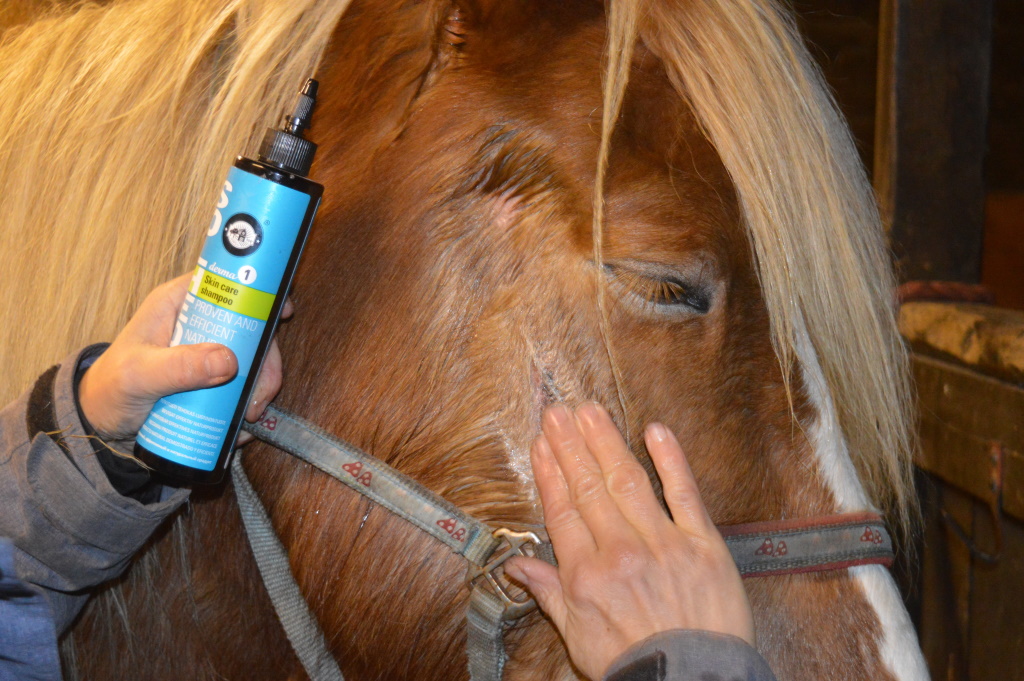
Mare’s inflamed tailroot during heat
As the day length increases, mares start going to heat after winter. For some of the mares, the first heats of the season cause skin inflammation. The inflammation is under the tailroot against bottom. Wet the inflamed skin and wash it with Derma1 skin care shampoo. Leave it on for approx. 3-5 minutes. Rinse the inflamed skin and the entire anus carefully. Dry the area and apply Derma13 Zinc Solution cream to the inflamed skin. Continue the treatment until the inflammation is over.
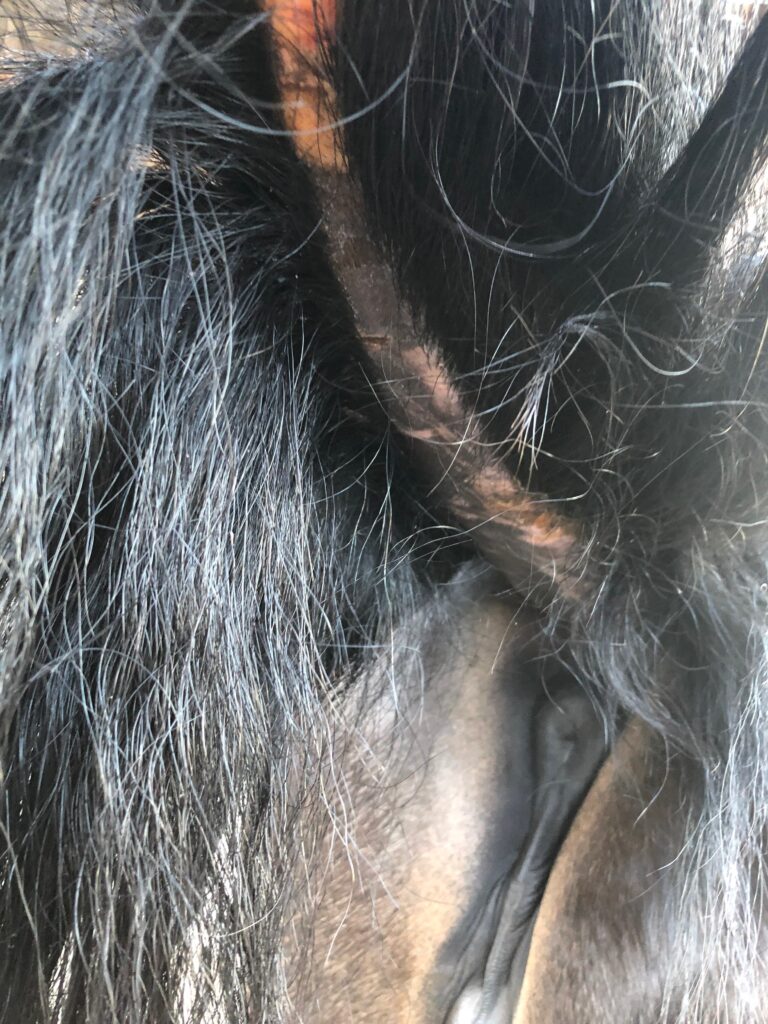
IDENTIFYING SKIN INFECTIONS
Typical symptom of skin infections is red, warm and itchy skin. Wide variety of microbes can cause skin infection. These microbes can be bacteria, virus, yeast, fungus or mold. Even parasites can be causative agents in skin infections. Infection caused by microbes is managed with antimicrobic treatment. Different antimicrobic substances are effective for different microbes. To identify the correct antimicrobic substance, we recommend taking a sample from the infection site to be cultivated for diagnostic use. The information on antibiotic specificity helps to choose effective product for the infection. The treatment can be local/topical and/or systemic. An example of systemic treatment as an oral antimicrobic treatment is antibiotics or sulfa.
Povidone iodine, hexetidine, miconazole nitrate and chlorhexetidine are typical synthetic antimicrobic compounds, which destroy wide range of various microbes. There are shampoos and lotions based on these compounds. These compounds can cause skin irritation. Many natural compounds e.g. pure essential oils: lavender, mint, lemongrass, thyme, oregano and many others have antimicrobic properties.
Early diagnosis leads to better treatment outcome. Early diagnosed infections can often be treated at home with topical treatment. The aim of the topical treatment is to clear the area of infection (disinfect). Treatment consists of washing the area off from microbes and applying antimicrobic lotion.
The frequency of the treatment is dependent of the severity and the grade of the infection. How successful this treatment is depends on the effectiveness of the compound on the causative, infective microbe. Some microbe strains are resistant to common antimicrobic compounds. Antimicrobic treatment should not be interrupted too early, as it could worsen the infection and make the microbes resistant to antimicrobic treatment.Mixing or using various products only few days to treat the infection can have similar effect. Thick and greasy products should be avoided as they accumulate dirt on the infection.
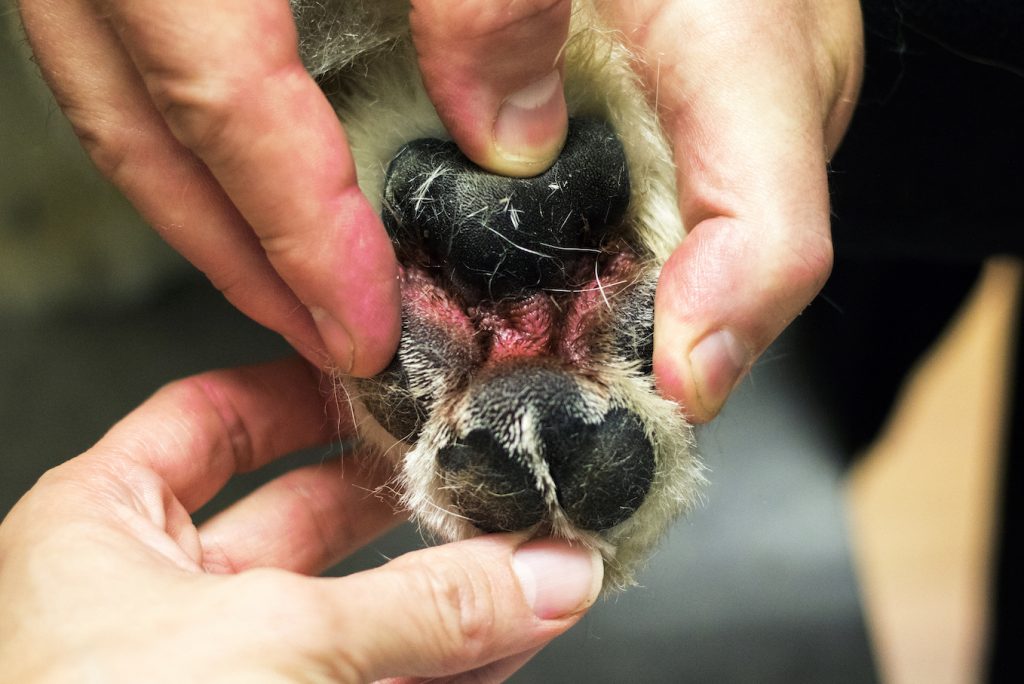
CHALLENGES OF INFECTIONS
Every infection is it’s own independent disease , even though they can look alike. Typical skin infection in horses is mud fever and in dogs paw infections and hotspots. In spite of the same disease name, the various animals can require different treatment for their hotspot/mud fever infection, depending on the causative microbe.
The infection can invade deeper skin layers, which can be seen as secretion of pus. These infections are usually very painful to the animals. Supportive local treatment can be applied in deeper infections of furunculosis ( “paw infection”) and hotspots. Horses’ mud fever if not treated, can invade the deeper skin layers. Shaving off the hair has been considered helpful in these deeper infections. If the skin infection is wide spread or intensive, the veterinarian will always need to evaluate the need for systemic antimicrobic medication. Localised infections can be treated locally unless they turn into a systematic infection. Localised treatment cannot effectively treat an area it does not reach.
Skin infections can become chronic problem. Local symptoms are treated locally and systemic systemically. Underlying allergy is often found in chronic skin infection, which exposes animal to infections. Thus possible allergy should be investigated and treated properly. The problem in animal’s chronic infections is the continuity. The successful treatment of the animal’s infection requires commitment of the care giver to the daily treatment till the infection is cured. Cats and dogs are usually easier to care for as they usually live in the same household than the caregiver. Horse owners will often need to arrange more care givers in order to provide daily treatment.
Veterinarian is the best person to analyse the comprehensive clinical situation and define the right treatment.
